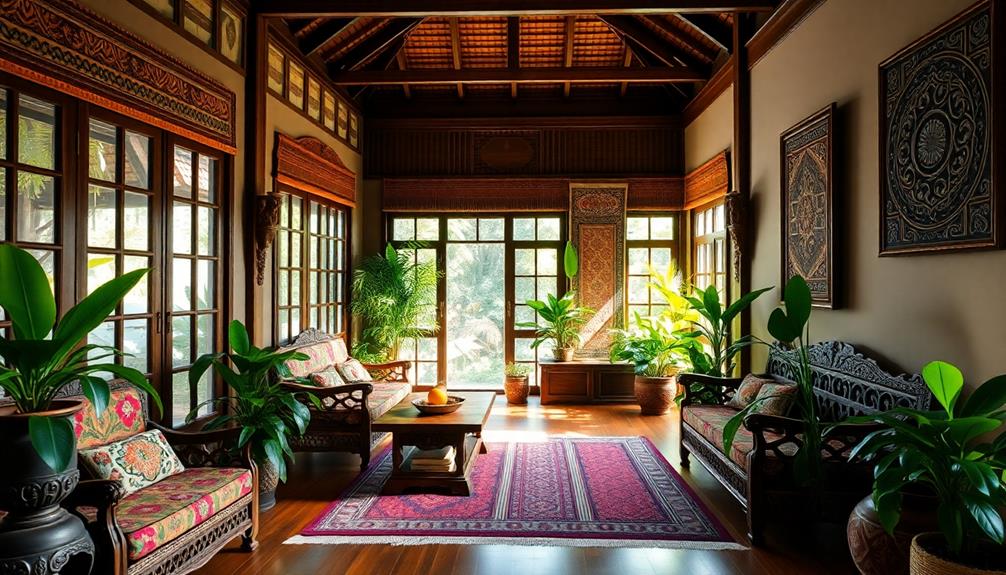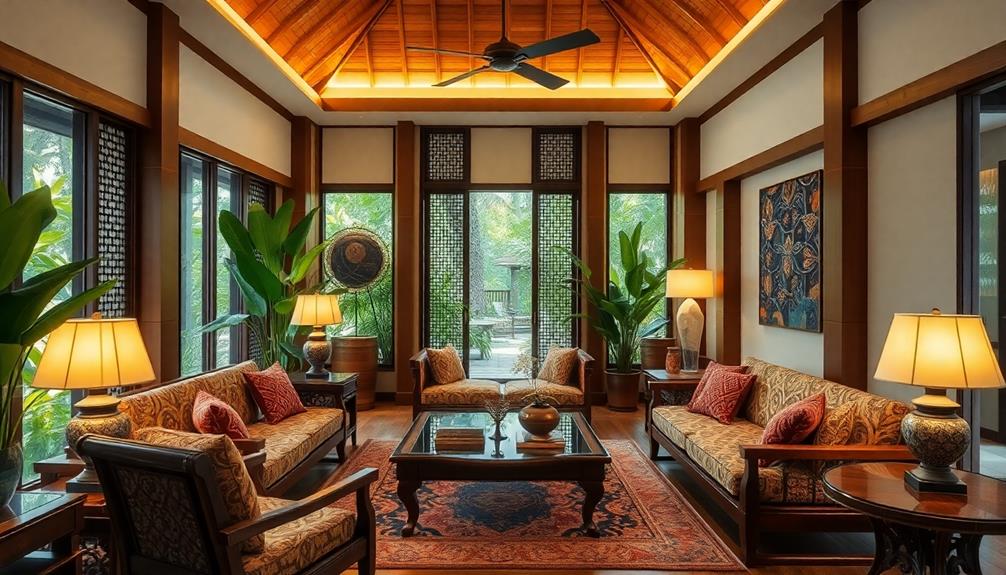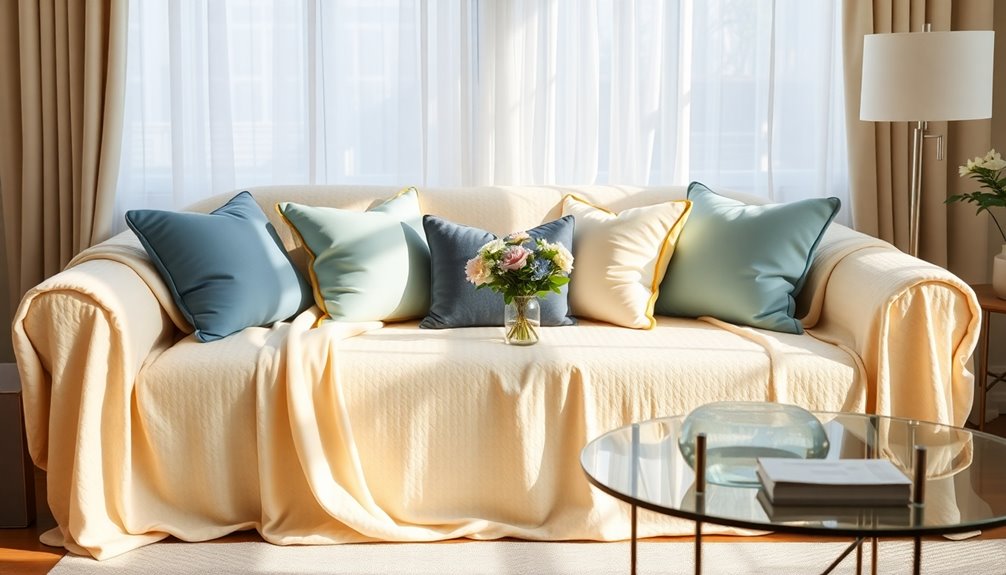When you delve into Indonesian house interiors, you will uncover a beautiful combination of culture and design. Each style, whether it’s the Balinese open-air concept or the tiered Joglo, showcases a connection with nature. The use of natural materials like teak, bamboo, and rattan not only supports sustainability but also elevates the visual appeal. Detailed wood carvings act as cultural centerpieces, telling stories of local folklore and traditions. Contemporary interpretations incorporate these elements while enhancing functionality. Ultimately, the ambiance created promotes a sense of peace and connection. Interested in learning more about how these components intertwine in distinct ways?
Key Takeaways
- Indonesian house interiors reflect diverse architectural styles, emphasizing cultural values and lifestyles, such as Balinese, Joglo, and Rumah Gadang designs.
- Natural materials like teak, bamboo, and stone are central to Indonesian design, promoting sustainability and enhancing aesthetics.
- Intricate wood carvings serve as cultural symbols, narrating local folklore and showcasing traditional craftsmanship in home decor.
- Open-air designs and large windows promote harmony with nature, enhancing natural light and airflow in tropical climates.
- Modern influences blend traditional aesthetics with sustainable practices, improving livability while maintaining cultural authenticity in home design.
Traditional Indonesian House Styles

Exploring the diverse architectural styles of traditional Indonesian houses reveals a rich tapestry of culture and community. Each region boasts unique designs that reflect its people's lifestyle and values, often incorporating spiritual elements and cultural symbolism that enhance their significance. For instance, the Minangkabau people of West Sumatra are known for their *Rumah Gadang*, with sweeping horn-like roofs and intricate carvings that symbolize protection and unity. Inside, **traditional Indonesian house interiors** often emphasize open communal spaces, fostering strong family connections and accommodating ritual gatherings. Such interiors are typically adorned with locally sourced materials like bamboo, woven mats, and ornate wooden furnishings, preserving a close relationship with nature.
For instance, the traditional Balinese house employs a harmonious blend of indoor and outdoor spaces, creating an open-air feel that fosters connection with nature. The Bale, a characteristic open pavilion, serves as a gathering place for ceremonies and daily life, showcasing the importance of family and tradition.
In West Sumatra, the Rumah Gadang impresses with its distinctive upward-curving roof and communal spaces, designed to accommodate large families. The Joglo House in Java, with its tiered roof, symbolizes social status, merging functionality with cultural significance.
Meanwhile, the Tongkonan houses of the Toraja people feature boat-shaped roofs and intricate decorations, acting as both living quarters and ceremonial sites.
Moving to Kalimantan, the Rumah Betang stands as a longhouse on stilts, fostering communal living among families.
Key Elements of Balinese Design
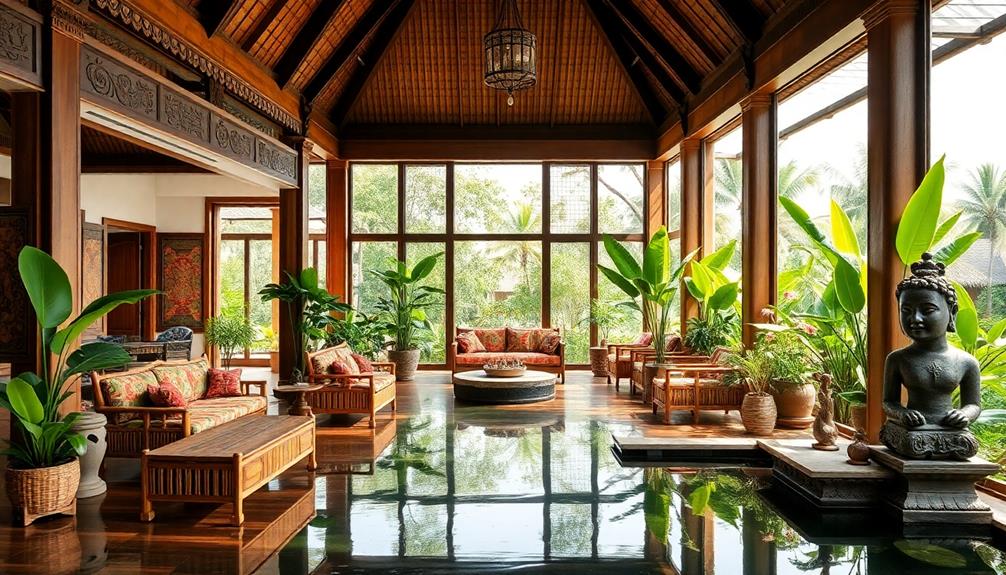
When you explore Balinese design, you'll notice a strong emphasis on natural materials like wood and stone that connect the space to the environment.
This approach not only enhances the aesthetic appeal but also promotes sustainability through the use of eco-friendly materials.
Intricate carvings also play a significant role, showcasing cultural motifs that reflect the island's rich traditions, as seen in traditional Balinese motifs and patterns.
Together, these elements create a harmonious and inviting atmosphere in your home.
Natural Materials Emphasis
Harmony with nature defines the essence of Balinese interior design, where natural materials play an essential role. In Balinese style, elements like wood, bamboo, and stone create a sustainable and inviting environment.
You'll often find furniture crafted from teak and suar wood, showcasing traditional craftsmanship that enhances the rustic aesthetic of your home. Additionally, the incorporation of vibrant Indonesian decorative pillows adds a pop of color and comfort that complements the organic materials beautifully.
Bamboo isn't just a primary construction material; it also shines in decorative items such as baskets and lampshades, highlighting its versatility and cultural significance. Incorporating these natural materials fosters a rich sensory experience, as textures like rattan and stone accents contribute to the serene ambiance typical of Balinese interiors.
The use of natural materials creates an open and airy atmosphere, blurring the lines between indoor and outdoor spaces. This design approach not only encourages a tropical living experience but also promotes a deeper connection to the environment.
Intricate Carvings Significance
Emphasizing the beauty of intricate wood carvings, Balinese design captivates with its rich cultural narratives and spiritual significance.
These carvings are more than just decorative elements; they serve as focal points in your home, often depicting deities and reflecting the deep-rooted Hindu influences present since the eighth century.
Additionally, incorporating unique art pieces, such as Indonesian decor masks, can further enhance the cultural ambiance of your living space.
Incorporating intricate wood carvings into your interior not only honors Balinese culture but also enhances the sacred ambiance of your living space.
Here are some key aspects of these carvings:
- Cultural Narratives: Each carving tells a story, reflecting Balinese mythology and traditions.
- Spiritual Significance: They play a crucial role in religious ceremonies, elevating the spiritual atmosphere of homes.
- Harmony Representation: The Tri Hita Karana philosophy is often depicted, promoting balance among humans, nature, and the divine.
- Artisan Craftsmanship: Handcrafted pieces celebrate traditional skills, adding authenticity to modern interiors.
- Visual Depth: The intricate detailing creates a serene and inviting environment, enhancing the overall aesthetic.
Materials That Define Spaces

When you think about Indonesian house interiors, local natural materials play an essential role in defining the space.
Traditional craftsmanship techniques bring these elements to life, creating a harmonious balance of color and texture.
Incorporating traditional artistry through unique decor pieces like masks can enhance the aesthetic appeal of your home.
Local Natural Materials
As you explore Indonesian interior design, you'll quickly notice how local natural materials shape the spaces within homes.
These elements not only enhance aesthetic appeal but also promote sustainability and foster harmony with the environment. By incorporating these materials, you'll find that each home tells a unique story of the region's rich resources, often reflecting a traditional Indonesian style that emphasizes connection to nature.
Key natural materials that define Indonesian interiors include:
- Teak Wood: A favorite for its durability and beautiful grain, often found in handcrafted wooden furniture and structural elements.
- Bamboo: Lightweight and flexible, it's commonly used in decor items and structural supports, showcasing local craftsmanship.
- Natural Stone: Sourced from local quarries, it adds a rustic charm through flooring, countertops, and decorative features.
- Rattan: Known for its versatility, rattan is often woven into furniture and accessories, blending comfort with style.
- Clay and Terracotta: These materials are used in pottery and tiles, adding earthy tones and textures to the interior space.
Traditional Craftsmanship Techniques
Drawing on centuries of tradition, Indonesian craftsmanship techniques play an essential role in shaping the character of interior spaces. When you incorporate locally sourced materials like wood, bamboo, and natural fibers, you not only honor the region's rich resources but also the artistry behind these bespoke pieces of furniture.
Intricate wood carvings found in Balinese and Javanese architecture serve as storytelling elements, reflecting cultural heritage while enhancing your home's aesthetic. Additionally, the unique artistry of Indonesian decor masks can add a striking visual element that celebrates local myths and folklore.
Rattan, a versatile and sustainable material, shines in both furniture and decor, perfectly suited for indoor and outdoor settings. You can create a harmonious atmosphere by integrating natural stone accents that foster a connection to the environment.
Handmade textiles, including woven baskets and traditional fabrics, add layers of texture and color, supporting local artisans and enriching your living space.
These traditional craftsmanship techniques guarantee that your home reflects authentic Indonesian culture. By thoughtfully selecting and showcasing these materials, you create an inviting atmosphere that resonates with history and artistry, making your interior truly unique and personal.
Color and Texture Harmony
Incorporating the rich textures and colors of Indonesian design enhances the atmosphere of your home. By embracing a warm, earthy color palette with whites, browns, greens, and terracotta, you create a seamless indoor-outdoor flow that promotes tranquility.
Utilizing natural materials like bamboo and rattan not only adds sustainability but also reflects the traditional craftsmanship that defines Indonesian interior design. To further enrich your decor, consider integrating elements inspired by Indonesian wedding decor ideas that showcase vibrant colors and intricate patterns.
To achieve the perfect harmony of color and texture, consider these elements:
- Smooth stones for a calming foundation
- Rough wood to add depth and character
- Soft fabrics for comfort and warmth
- Vibrant color accents inspired by tropical flora
- Raw wood flooring to enrich your space
Mixing these textures creates visual interest while embodying the island's natural beauty.
You can also incorporate low-profile furniture made from natural materials, fostering a relaxed atmosphere that enhances the overall aesthetic appeal. By integrating traditional elements with modern styles, you'll achieve a harmonious balance that defines the unique charm of Indonesian home design.
Cultural Significance of Wood Carvings
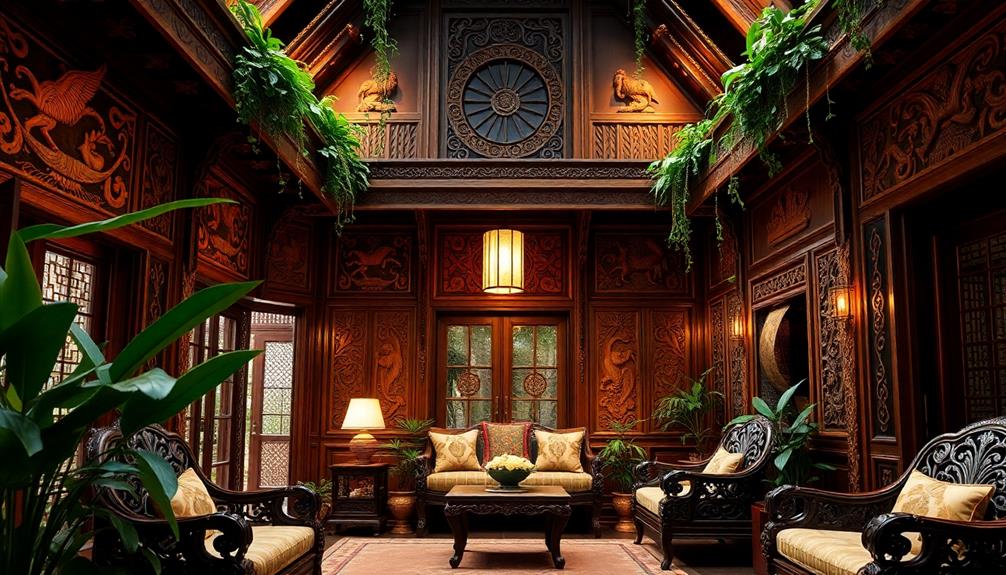
Wood carvings hold a significant place in Indonesian house interior design, serving not just as decorative elements but as rich cultural symbols. In traditional houses, these intricate carvings often act as focal points, showcasing the exceptional skills of local artisans, especially in regions like Bali and Java. They date back to the arrival of Hinduism in Indonesia during the eighth century, often honoring deities and playing crucial roles in religious ceremonies.
Many modern designs incorporate these elements, reflecting the unique aesthetic of Bali's luxury interiors, which often emphasize tropical-themed luxury design.
The motifs depicted in these carvings narrate local folklore and traditions, making them essential to your cultural identity. Each piece tells a story, connecting your home to its historical roots.
You'll find that modern use of wood carvings reflects the Tri Hita Karana philosophy, which emphasizes harmony among humans, nature, and the divine. This philosophy influences contemporary home decor while still respecting traditional craftsmanship.
Modern Influences on Traditional Architecture

As you explore Indonesian house interior design, you'll notice how modern influences are reshaping traditional architecture.
Today, innovative architects blend traditional materials with modern aesthetics, creating spaces that honor cultural heritage while meeting contemporary needs. This evolution reflects a vibrant dialogue between past and present, emphasizing the importance of modern tropical aesthetics in Bali.
Here are some key aspects of this architectural transformation:
- Sustainable Design: Incorporating eco-friendly principles using wood and bamboo as traditional materials.
- Open Floor Plans: Adapting layouts to enhance natural ventilation and light, perfect for the tropical climate.
- Cultural Reinterpretation: Emerging architects reinterpret classic styles, like Joglo and Rumah Gadang, enhancing livability with modern amenities.
- Urban Fusion: In cities like Jakarta, intricate carvings and local motifs merge with minimalistic designs, showcasing a unique identity.
- Global Trends: Designers explore new technologies and materials while remaining rooted in local craftsmanship.
This blend of modern influences with traditional architecture not only preserves Indonesia's rich cultural narrative but also embraces the future, ensuring that homes are functional, beautiful, and sustainable.
Sustainable Practices in Home Design
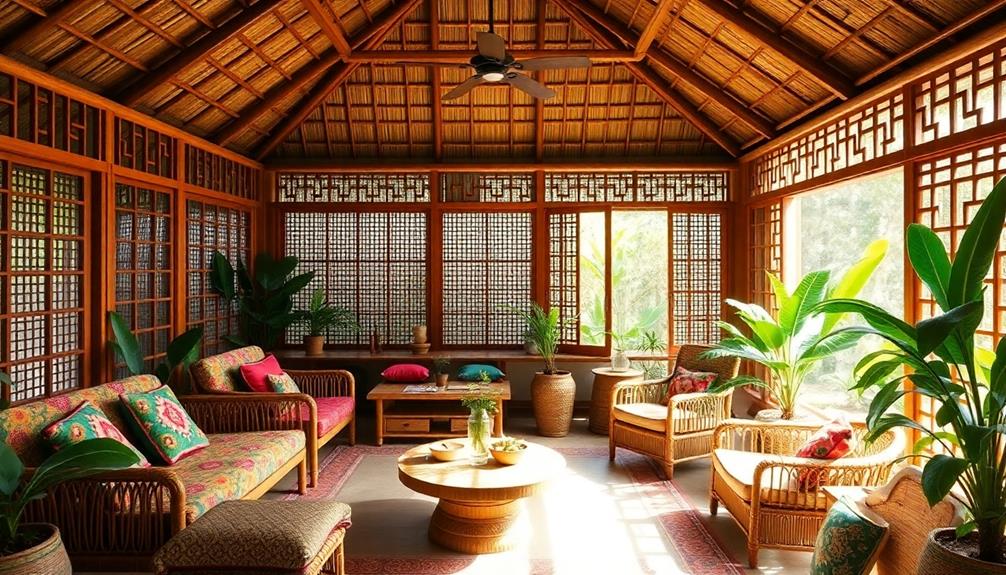
In recent years, sustainable practices in home design have gained significant traction in Indonesia, reflecting a growing awareness of environmental impact and cultural heritage.
You'll find that many designs emphasize the use of locally sourced natural materials like bamboo and rattan. This not only reduces carbon footprints but also supports local craftsmanship and economies.
Traditional Indonesian houses, such as Rumah Gadang and Tongkonan, are elevated on stilts, effectively mitigating risks associated with flooding and pests. These designs promote airflow and temperature regulation, which is essential in Indonesia's tropical climate.
Open-air designs, commonly seen in Balinese pavilions, enhance natural ventilation, minimizing the need for artificial cooling systems and improving energy efficiency.
Architectural projects like Tegel House showcase a limited material palette, engaging local artisans to create low-carbon footprints while fostering cultural exchange.
Additionally, incorporating water features into your home design not only elevates aesthetics but also provides natural cooling, contributing to a serene ambiance.
Creating Harmony With Nature

Building on the sustainable practices that define contemporary Indonesian home design, creating harmony with nature becomes a guiding principle.
You'll find that Indonesian interiors often feature open floor plans and large windows, allowing natural light to flood in and promoting seamless airflow. This connection to the surrounding environment fosters a tranquil atmosphere.
To enhance this harmony, consider integrating the following elements into your living spaces:
- Natural materials: Use bamboo, teak, and stone for an authentic touch.
- Indoor-outdoor integration: Incorporate lush greenery and water elements, like ponds or fountains.
- Traditional motifs: Celebrate local craftsmanship through intricate carvings in furniture and decor.
- Fluid furniture placement: Arrange pieces to encourage smooth connections between spaces.
- Maximized natural light: Guarantee your design allows sunlight to illuminate each area.
Frequently Asked Questions
What Is the Traditional Indonesian House on Stilts?
A traditional Indonesian house on stilts is an elevated structure designed to protect against flooding. It features communal spaces, local materials, and intricate carvings, reflecting the rich cultural heritage and community values of Indonesia.
What Is an Indonesian Traditional House?
Did you know that over 300 ethnic groups in Indonesia each have distinct traditional houses? An Indonesian traditional house reflects cultural identity, showcasing unique architecture, intricate carvings, and communal spaces, all while promoting sustainability with local materials.
What Do Indonesia Houses Look Like?
Indonesian houses showcase diverse styles, like the Rumah Gadang with its distinctive roof and communal spaces, or the Joglo's tiered design. Each reflects regional culture, utilizing local materials and intricate carvings that celebrate tradition and craftsmanship.
Conclusion
As you finish exploring Indonesian house interiors, you might find it amusing that amidst the intricate wood carvings and peaceful designs, the true art lies in the effortless blend of tradition and modernity. You'd think such a harmonious balance would be difficult to achieve, yet it seems that when you embrace both the old and the new, the result is surprisingly simple. So, go ahead—let your home reflect this enchanting cultural dance, and watch as it effortlessly transforms into a sanctuary.
